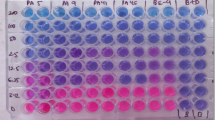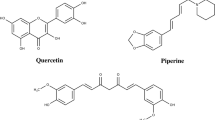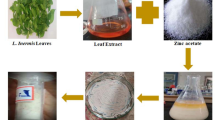Abstract
Acanthamoeba is an opportunistic protozoan parasite responsible for different diseases in humans, such as granulomatous amoebic encephalitis and amoebic keratitis. Tigecycline, a third-generation tetracycline antibiotic, has potential activity to treat most of the antibiotic resistant bacterial infections. The effects of tigecycline in eukaryotic cells as well as parasites are less well studied. In the present study, we tested the effects of tigecycline on trophozoites of Acanthamoeba castellanii. The inhibitory effect of tigecycline on Acanthamoeba was determined by resazurin reduction and trypan blue exclusion assays. We found that tigecycline significantly inhibited the growth of Acanthamoeba (46.4 % inhibition at the concentration of 100 μM) without affecting cell viability and induction of encystation, whereas other tetracycline groups of antibiotics such as tetracycline and doxycycline showed no inhibitory effects. Furthermore, tigecycline decreased cellular adenosine triphosphate (ATP) level by 26 % than the control and increased mitochondrial mass, suggesting mitochondrial dysfunction in tigecycline-treated cells. These findings suggest that mitochondrial dysfunction with decreased ATP production might play an important mechanism of tigecycline in suppression of Acanthamoeba proliferation.




Similar content being viewed by others
References
Aichelburg AC et al (2008) Successful treatment of disseminated Acanthamoeba spp. infection with miltefosine. Emerg Infect Dis 14(11):1743–6
Aqeel Y, Siddiqui R, Iftikhar H, Khan NA (2013) The effect of different environmental conditions on the encystation of Acanthamoeba castellanii belonging to the T4 genotype. Exp Parasitol 135(1):30–5
Baig AM, Iqbal J, Khan NA (2013) In vitro efficacies of clinically available drugs against growth and viability of an Acanthamoeba castellanii keratitis isolate belonging to the T4 genotype. Antimicrob Agents Chemother 57(8):3561–7
Bang S, Edell E, Eghrari AO, Gottsch JD (2010) Treatment with voriconazole in 3 eyes with resistant Acanthamoeba keratitis. Am J Ophthalmol 149(1):66–9
Bauer G, Berens C, Projan SJ, Hillen W (2004) Comparison of tetracycline and tigecycline binding to ribosomes mapped by dimethylsulphate and drug-directed Fe2+ cleavage of 16S rRNA. J Antimicrob Chemother 53(4):592–9
Bouyer S, Imbert C, Daniault G, Cateau E, Rodier MH (2007) Effect of caspofungin on trophozoites and cysts of three species of Acanthamoeba. J Antimicrob Chemother 59(1):122–4
Clarke B, Sinha A, Parmar DN, Sykakis E (2012) Advances in the diagnosis and treatment of Acanthamoeba keratitis. J Ophthalmol 2012:484892. doi:10.1155/2012/484892
Fields RD, Lancaster MV (1993) Dual-attribute continuous monitoring of cell proliferation/cytotoxicity. Am Biotechnol Lab 11(4):48–50
Gerasimovskaya EV et al (2005) Extracellular ATP-induced proliferation of adventitial fibroblasts requires phosphoinositide 3-kinase, Akt, mammalian target of rapamycin, and p70 S6 kinase signaling pathways. J Biol Chem 280(3):1838–48
Gonzalvez F et al (2013) Barth syndrome: cellular compensation of mitochondrial dysfunction and apoptosis inhibition due to changes in cardiolipin remodeling linked to tafazzin (TAZ) gene mutation. Biochim Biophys Acta 1832(8):1194–206
Heredero-Bermejo I, Copa-Patino JL, Soliveri J, Gomez R, de la Mata FJ, Perez-Serrano J (2013) In vitro comparative assessment of different viability assays in Acanthamoeba castellanii and Acanthamoeba polyphaga trophozoites. Parasitol Res 112(12):4087–95
Illingworth CD, Cook SD, Karabatsas CH, Easty DL (1995) Acanthamoeba keratitis: risk factors and outcome. Br J Ophthalmol 79(12):1078–82
Khan NA (2006) Acanthamoeba: biology and increasing importance in human health. FEMS Microbiol Rev 30(4):564–95
Kumar R, Lloyd D (2002) Recent advances in the treatment of Acanthamoeba keratitis. Clin Infect Dis 35(4):434–41
Larson EM, Doughman DJ, Gregerson DS, Obritsch WF (1997) A new, simple, nonradioactive, nontoxic in vitro assay to monitor corneal endothelial cell viability. Invest Ophthalmol Vis Sci 38(10):1929–33
Leiter LM, Thatte HS, Okafor C, Marks PW, Golan DE, Bridges KR (1999) Chloramphenicol-induced mitochondrial dysfunction is associated with decreased transferrin receptor expression and ferritin synthesis in K562 cells and is unrelated to IRE-IRP interactions. J Cell Physiol 180(3):334–44
Lorenzo-Morales J, Martin-Navarro CM, Lopez-Arencibia A, Arnalich-Montiel F, Pinero JE, Valladares B (2013) Acanthamoeba keratitis: an emerging disease gathering importance worldwide? Trends Parasitol 29(4):181–7
Malatyali E, Tepe B, Degerli S, Berk S, Akpulat HA (2012) In vitro amoebicidal activity of four Peucedanum species on Acanthamoeba castellanii cysts and trophozoites. Parasitol Res 110(1):167–74
Marciano-Cabral F, Cabral G (2003) Acanthamoeba spp. as agents of disease in humans. Clin Microbiol Rev 16(2):273–307
Marcussen M, Larsen PJ (1996) Cell cycle-dependent regulation of cellular ATP concentration, and depolymerization of the interphase microtubular network induced by elevated cellular ATP concentration in whole fibroblasts. Cell Motil Cytoskeleton 35(2):94–9
Markowitz SM, Sobieski T, Martinez AJ, Duma RJ (1978) Experimental Acanthamoeba infections in mice pretreated with methylprednisolone or tetracycline. Am J Pathol 92(3):733–44
Martin-Navarro CM et al (2014) PrestoBlue(R) and AlamarBlue(R) are equally useful as agents to determine the viability of Acanthamoeba trophozoites. Exp Parasitol. doi:10.1016/j.exppara.2014.03.024
McBride J, Ingram PR, Henriquez FL, Roberts CW (2005) Development of colorimetric microtiter plate assay for assessment of antimicrobials against Acanthamoeba. J Clin Microbiol 43(2):629–34
McBride J, Mullen AB, Carter KC, Roberts CW (2007) Differential cytotoxicity of phospholipid analogues to pathogenic Acanthamoeba species and mammalian cells. J Antimicrob Chemother 60(3):521–5
Moiseeva O, Bourdeau V, Roux A, Deschenes-Simard X, Ferbeyre G (2009) Mitochondrial dysfunction contributes to oncogene-induced senescence. Mol Cell Biol 29(16):4495–507
Nakashima-Kamimura N et al (2005) MIDAS/GPP34, a nuclear gene product, regulates total mitochondrial mass in response to mitochondrial dysfunction. J Cell Sci 118(Pt 22):5357–67
Olson MW, Ruzin A, Feyfant E, Rush TS 3rd, O’Connell J, Bradford PA (2006) Functional, biophysical, and structural bases for antibacterial activity of tigecycline. Antimicrob Agents Chemother 50(6):2156–66
Perez-Rangel A et al (2013) Albendazole and its derivative JVG9 induce encystation on Giardia intestinalis trophozoites. Parasitol Res 112(9):3251–7
Qvarnstrom Y, Nerad TA, Visvesvara GS (2013) Characterization of a new pathogenic Acanthamoeba Species, A. byersi n. sp., isolated from a human with fatal amoebic encephalitis. J Eukaryot Microbiol 60(6):626–33
Rolon M, Vega C, Escario JA, Gomez-Barrio A (2006) Development of resazurin microtiter assay for drug sensibility testing of Trypanosoma cruzi epimastigotes. Parasitol Res 99(2):103–7
Rose WE, Rybak MJ (2006) Tigecycline: first of a new class of antimicrobial agents. Pharmacotherapy 26(8):1099–110
Sholl-Franco A, Fragel-Madeira L, Macama Ada C, Linden R, Ventura AL (2010) ATP controls cell cycle and induces proliferation in the mouse developing retina. Int J Dev Neurosci 28(1):63–73
Siddiqui R, Khan NA (2012) Biology and pathogenesis of Acanthamoeba. Parasit Vectors 5:6. doi:10.1186/1756-3305-5-6
Skrtic M et al (2011) Inhibition of mitochondrial translation as a therapeutic strategy for human acute myeloid leukemia. Cancer Cell 20(5):674–88
Slover CM, Rodvold KA, Danziger LH (2007) Tigecycline: a novel broad-spectrum antimicrobial. Ann Pharmacother 41(6):965–72
Visvesvara GS, Moura H, Schuster FL (2007) Pathogenic and opportunistic free-living amoebae: Acanthamoeba spp., Balamuthia mandrillaris, Naegleria fowleri, and Sappinia diploidea. FEMS Immunol Med Microbiol 50(1):1–26
Walochnik J et al (2002) Cytotoxic activities of alkylphosphocholines against clinical isolates of Acanthamoeba spp. Antimicrob Agents Chemother 46(3):695–701
Walochnik J et al (2009) Anti-Acanthamoeba efficacy and toxicity of miltefosine in an organotypic skin equivalent. J Antimicrob Chemother 64(3):539–45
Waterhouse NJ, Goldstein JC, von Ahsen O, Schuler M, Newmeyer DD, Green DR (2001) Cytochrome c maintains mitochondrial transmembrane potential and ATP generation after outer mitochondrial membrane permeabilization during the apoptotic process. J Cell Biol 153(2):319–28
Webster D et al (2012) Treatment of granulomatous amoebic encephalitis with voriconazole and miltefosine in an immunocompetent soldier. Am J Trop Med Hyg 87(4):715–8
Author information
Authors and Affiliations
Corresponding author
Rights and permissions
About this article
Cite this article
Jha, B.K., Seo, I., Kong, HH. et al. Tigecycline inhibits proliferation of Acanthamoeba castellanii . Parasitol Res 114, 1189–1195 (2015). https://doi.org/10.1007/s00436-014-4302-1
Received:
Accepted:
Published:
Issue Date:
DOI: https://doi.org/10.1007/s00436-014-4302-1




